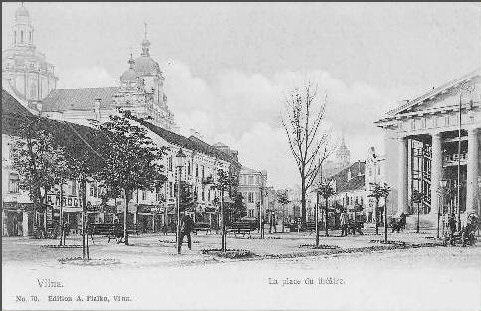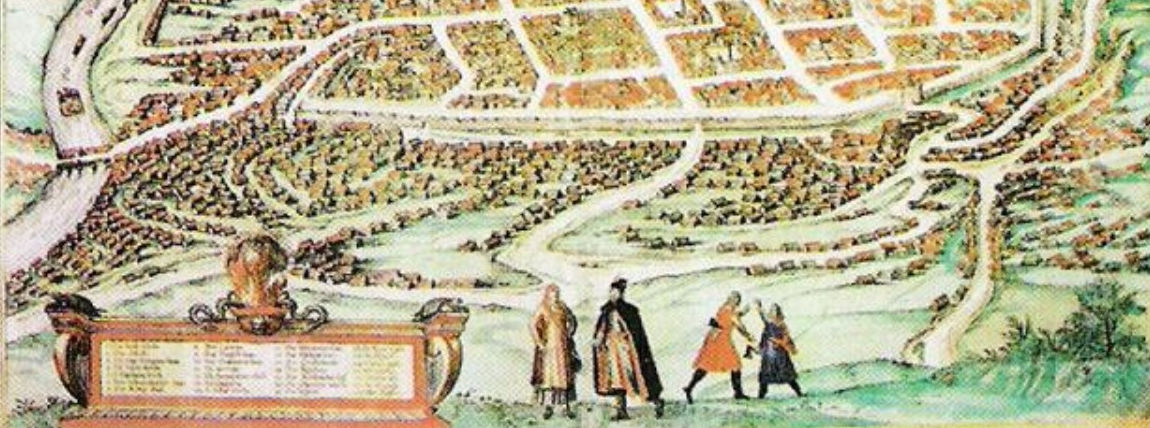Historian Sigita GASPARAVICIENE
Townhall square.Until mid 17th c. this was the square of public hanging. Other public city events such as acrobat shows, religious mysteries, etc. used to take place here. In the beginning of the 19th c. this was the first public city square built in front of the former Town Hall, later converted into the city theatre. Initially it was boulevard-shaped and lead from the Town Hall building to Stiklių street. The square was surrounded by four rows or pyramid poplars and decorative bushes and enclosed by a wooden fence. There also were wooden benches.

In the 2nd half of the 19th c. the square was enclosed by a see-through metal fence on a concrete base. Lawns were planted in the square with decorative trees and bushes, narrow paths and two round squares. In 1885 Vilnius Garden Commission took care of the square renovation when 12 poplars were built, the garden landscaped and pavilions built. In 1908 and 1914 the square was redeveloped again - the grass was planted and the fence built. From the end of the 19th c. through till the beginning of 20th c. the square was used for Christmas tree fairs that used to take place before Christmas.
St. George’s Square (today’s Municipality Square). At the end of the 18th c. instead of the square there used to be a huge garden. A square was shaped in this location in the beginning of the 19th c., where a double row of trees was planted on four sides in the 2nd quarter of the 19th c. There was no vegetation in the middle of the square and it was used as a market place. In 1860 the Square of St. George was built here, and in 1865 a chapel of Alexander Newski in commemoration of Russian soldiers killed during the revolt of 1963 was built in the middle of the square. The yearly flower market traditionally used to take place here at the end of April. Before World War II the square was redeveloped – it became more pictorial, closed. It remained like that onwards when after the war a monument to General I .Tcherniachovskij was erected.
Other city squares. In the 2nd half of the 19th c. the following city squares were reconstructed:
- a small triangular square by the Bonifratres Church nearby the today’s Presidency Garden-Park;
- a square by St. Catherine’s Church where the bust of composer S.Moniuhko was erected after World War I.
- a square by the Sobor of Innocent God’s Mother in today’s Maironio street,
- a square by today’s Visų Šventųjų street that was expanded after the war.
Before the 2nd World War in the 20th c. a new closed square was set up at the Franciscan Church on Trakų street boasting a monument to patron of arts J.Montvila (Montwillo)
City courtyards. A beautifully landscaped Vilnius University Poczobutt Courtyard (in front of the observatory) was even called the university garden.
Even today there are hundred-years-old maples. Other university courtyards had single trees growing. There had been no vegetation if Skarga Courtyard until the beginning of the 20th c. These courtyards were adorned with vines and decorative bushes only after World War I.
Courtyard of the Bonifratres Church was landscaped only in the beginning of the 18th c. The courtyard was up till today planted with fruit trees and decorative bushes.
Courtyard of the first Botanical Gardens at today’s 22 Pilies street. In 1782 Vilnius University Professors J.E. Gilbert and G.Forster set up the first Vilnius Botanical Gardens in it.
Courtyard of the Franciscan Monastery .From the end of the 19th c. through to the beginning of the 20th c. this courtyard had orderly laid out lawns with a centrepiece flowerbed. Lawn edges were planted with poplars. Various exhibitions were often arranged in the courtyard.
Streets.
Rows of trees were not planted along streets of the 18th c. Vilnius Old Town. Earlier mentioned boulevard of Arsenalo Street was then on the edge of the city. Suburban streets that were in fact only roads leading to stand-alone manor houses were often planted alongside with poplar alleys. From the end of the 18th c. through till the beginning of the 19th c. only selected parts of streets and openings (honour courtyards) in front of significant public buildings were landscaped in the Old Town. Landscaping of this type used to be at the Town Hall (before the boulevard-type square was built) and the opening before St. Casimir’s Church. Rows of poplars were planted alongside the yard to honour the latter. Only a small fence was separating it from the street.
In the beginning of the 19th c. rows of poplars were also planted in the university honorary courtyard near today’s’ Daukanto Square . From the 2nd half of the 19th c. to the beginning of the 20th c. trees were planted all along newly built streets, such as today’s Gedimino Avenue, Maironio street, etc, whereas in the old streets trees were only planted in openings in front of individual buildings. A good example of this is an opening in front of St. Johns’ Church.
Condition of City green spaces in between world wars I and II.
Green spaces in the central city part and suburbs were poorly maintained and completely neglected at the end of the 40s. Pushkin Square, called Veršynas(Calf-tender) at the time. Was very neglected and unattractive. City squares were dirty and dug up, with trees cut and overgrown with weed. During the major flood in 1931 a better part of River Neris embankment was destroyed and many lime trees that were growing along the banks fell.
Over 1937-1939 in an attempt to muffle the condition of the green spaces of the central city and the Old Town Vilnius City Magistrate arranged contests for decoration of balconies and flower gardens in front of buildings. These contests have significantly improved the esthetical side of the city development, especially during the summers.








